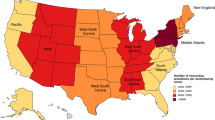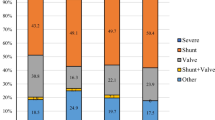Abstract
Congenital heart disease (CHD) is the most common birth anomaly in the US. Research shows lost-to-follow-up trends and racial disparities in healthcare use. This study examines racial differences in healthcare use among Medicaid-covered children with CHD. Using 2010–2019 claims data from a pediatric Medicaid Accountable Care Organization, 960 Black and White children with complex CHD and ≥ 3 years of continuous Medicaid coverage were identified. Three cohorts were constructed (starting age: < 1-year-olds, 1–5-year-olds, 6–15-year-olds) and followed for 3 years. Multivariate analysis assessed annual healthcare use (cardiology, primary care, emergency department) by race, adjusting for patient and provider covariates. Overall, 51% of patients had an annual cardiology visit, and 54% had an annual primary care visit. Among the 1–5-year-old cohort, Black children were predicted to be 13% less likely to have an annual cardiology visit compared to their White counterparts (p = 0.001). Older Black children were predicted to be more likely to have a primary care visit compared to their White counterparts. Nearly half of Medicaid-enrolled children with complex CHD did not receive recommended cardiology care. Young Black children were less likely to receive an annual cardiac visit, while older Black children were more likely to receive primary care. While the percentage with an annual cardiac visit was low, the majority had seen a cardiologist within the 3-year window, suggesting these children are still receiving cardiology care, if less frequently than recommended. Opportunities exist for cardiology and primary care to collaborate to ensure patients receive timely recommended care.

Similar content being viewed by others
References
Centers for Disease Control and Prevention. Data and Statistics on Congenital Heart Defects (2022). https://www.cdc.gov/ncbddd/heartdefects/data.html. Accessed 1 Mar 2022
Roche SL, Silversides CK (2013) Hypertension, obesity, and coronary artery disease in the survivors of congenital heart disease. Can J Cardiol 29:841–848
Greutmann M, Tobler D, Kovacs AH, Greutmann-Yantiri M, Haile SR, Held L, Ivanov J, Williams WG, Oechslin EN, Silversides CK, Colman JM (2015) Increasing mortality burden among adults with complex congenital heart disease. Congenit Heart Dis 10:117–127
Jackson JL, Morack J, Harris M, DeSalvo J, Daniels CJ, Chisolm DJ (2019) Racial disparities in clinic follow-up early in life among survivors of congenital heart disease. Congenit Heart Dis 14:305–310
Lin CJ, Novak E, Rich MW, Billadello JJ (2018) Insurance access in adults with congenital heart disease in the Affordable Care Act era. Congenit Heart Dis 13:384–391
Gurvitz M, Valente AM, Broberg C, Cook S, Stout K, Kay J, Ting J, Kuehl K, Earing M, Webb G, Houser L, Opotowsky A, Harmon A, Graham D, Khairy P, Gianola A, Verstappen A, Landzberg M, Alliance for Adult Research in Congenital C, Adult Congenital Heart A (2013) Prevalence and predictors of gaps in care among adult congenital heart disease patients: HEART-ACHD (The Health, Education, and Access Research Trial). J Am Coll Cardiol 61:2180–2184
Stout KK, Daniels CJ, Aboulhosn JA, Bozkurt B, Broberg CS, Colman JM, Crumb SR, Dearani JA, Fuller S, Gurvitz M, Khairy P, Landzberg MJ, Saidi A, Valente AM, Van Hare GF (2019) 2018 AHA/ACC guideline for the management of adults with congenital heart disease: a report of the American College of Cardiology/American Heart Association Task Force on Clinical Practice Guidelines. J Am Coll Cardiol 73:e81–e192
Yeung E, Kay J, Roosevelt GE, Brandon M, Yetman AT (2008) Lapse of care as a predictor for morbidity in adults with congenital heart disease. Int J Cardiol 125:62–65
Fixler DE, Nembhard WN, Salemi JL, Ethen MK, Canfield MA (2010) Mortality in first 5 years in infants with functional single ventricle born in Texas, 1996 to 2003. Circulation 121:644–650
Lopez KN, Morris SA, Sexson Tejtel SK, Espaillat A, Salemi JL (2020) US mortality attributable to congenital heart disease across the lifespan from 1999 through 2017 exposes persistent racial/ethnic disparities. Circulation 142:1132–1147
Tsaur S, Gleason L, Kim Y (2018) Quality indicator completion rates for adults with tetralogy of Fallot. Pediatr Cardiol 39:1700–1706
Chan A, Aijaz A, Zaidi AN (2020) Surgical outcomes in complex adult congenital heart disease: a brief review. J Thorac Dis 12:1224
Huisenga D, La Bastide-Van GS, Van Bergen A, Sweeney J, Hadders-Algra M (2021) Developmental outcomes after early surgery for complex congenital heart disease: a systematic review and meta-analysis. Dev Med Child Neurol 63:29–46
Marelli AJ, Ionescu-Ittu R, Mackie AS, Guo L, Dendukuri N, Kaouache M (2014) Lifetime prevalence of congenital heart disease in the general population from 2000 to 2010. Circulation 130:749–756
Lu JC, Lowery R, Yu S, Mahani MG, Agarwal PP, Dorfman AL (2017) Predictors of missed appointments in patients referred for congenital or pediatric cardiac magnetic resonance. Pediatr Radiol 47:911–916
Davey B, Sinha R, Lee JH, Gauthier M, Flores G (2021) Social determinants of health and outcomes for children and adults with congenital heart disease: a systematic review. Pediatr Res 89:275–294
Tillman AR, Colborn KL, Scott KA, Davidson AJ, Khanna A, Kao D, McKenzie L, Ong T, Rausch CM, Duca LM (2021) Associations between socioeconomic context and congenital heart disease related outcomes in adolescents and adults. Am J Cardiol 139:105–115
Khan AM, McGrath LB, Ramsey K, Agarwal A, Slatore CG, Broberg CS (2022) Distance to care, rural dwelling status, and patterns of care utilization in adult congenital heart disease. Pediatr Cardiol 43:532–540
McGrath L, Taunton M, Levy S, Kovacs AH, Broberg C, Khan A (2022) Barriers to care in urban and rural dwelling adults with congenital heart disease. Cardiol Young 32:612–617
Dabson B, Kumar C (2021) Rural development: a scan of field practice and trends. Aspen Institute, Community Strategies Group
KIDS COUNT. Child Population in Ohio (2022). https://datacenter.kidscount.org/data/tables/7190-child-population#detailed/5/5178-5265/false/1729,37,871,870,573,869,36,868,867,133/any/15123. Accessed 1 Mar 2022
American Heart Association (2001) 32nd Bethesda conference task force for adults with congenital heart disease. J Am Coll Cardiol 37:1168–1198
Khan A, Ramsey K, Ballard C, Armstrong E, Burchill LJ, Menashe V, Pantely G, Broberg CS (2018) Limited accuracy of administrative data for the identification and classification of adult congenital heart disease. J Am Heart Assoc 7:e007378
Manning WG, Basu A, Mullahy J (2005) Generalized modeling approaches to risk adjustment of skewed outcomes data. J Health Econ 24:465–488
RUCA Data: Using RUCA Data (2020). https://depts.washington.edu/uwruca/ruca-uses.php. Accessed 1 Jul 2020
Robert Graham Center - Policy Studies in Family Medicine & Primary Care (ed) (2019) Social deprivation index (SDI)
Feudtner C, Feinstein JA, Zhong W, Hall M, Dai D (2014) Pediatric complex chronic conditions classification system version 2: updated for ICD-10 and complex medical technology dependence and transplantation. BMC Pediatr 14:199
Silber JH, Rosenbaum PR, Calhoun SR, Reiter JG, Hill AS, Guevara JP, Zorc JJ, Even-Shoshan O (2017) Racial disparities in medicaid asthma hospitalizations. Pediatrics. https://doi.org/10.1542/peds.2016-1221
Sohn H, Timmermans S (2019) Inequities in newborn screening: race and the role of medicaid(☆). SSM Popul Health 9:100496
Bilaver LA, Sobotka SA, Mandell DS (2021) Understanding racial and ethnic disparities in autism-related service use among medicaid-enrolled children. J Autism Dev Disord 51:3341–3355
Keet CA, Matsui EC, McCormack MC, Peng RD (2017) Urban residence, neighborhood poverty, race/ethnicity, and asthma morbidity among children on Medicaid. J Allergy Clin Immunol 140:822–827
Douthit N, Kiv S, Dwolatzky T, Biswas S (2015) Exposing some important barriers to health care access in the rural USA. Public Health 129:611–620
Weigel PA, Ullrich F, Shane DM, Mueller KJ (2016) Variation in primary care service patterns by rural-urban location. J Rural Health 32:196–203
Hatef E, Ma X, Rouhizadeh M, Singh G, Weiner JP, Kharrazi H (2021) Assessing the impact of social needs and social determinants of health on health care utilization: using patient-and community-level data. Popul Health Manag 24:222–230
O’Gurek DT, Henke C (2018) A practical approach to screening for social determinants of health. Fam Pract Manag 25:7–12
Cohen S, Jannot AS, Iserin L, Bonnet D, Burgun A, Escudie JB (2019) Accuracy of claim data in the identification and classification of adults with congenital heart diseases in electronic medical records. Arch Cardiovasc Dis 112:31–43
National Center for Health Statistics (2019) Child population by race and Hispanic origin in Ohio. The Annie E. Casey Foundation KIDS COUNT Data Center. https://datacenter.aecf.org/data/tables/7191-child-population-by-race-and-hispanic-origin?loc=37&loct=2#detailed/2/any/false/1729,37,871,870,573,869,36,868,867,133/107,133,172,3,10/14235. Accessed 26 May 2023
U.S. Census Bureau (2019) Children who have health insurance by health insurance type in Ohio. Annie E. Casey Foundation. https://datacenter.aecf.org/data/tables/10183-children-who-have-health-insurance-by-health-insurance-type?loc=37&loct=2#detailed/2/37/false/2048,1729,37,871/4847,4848,4849,4153,2807,2811/19706,19707. Accessed 26 May 2023
Pollard K, Jacobsen LA (2019) The Appalachian region: a data overview from the 2013–2017 American Community Survey. Chartbook. Appalachian Regional Commission
Edelson JB, Rossano JW, Griffis H, Quarshie WO, Ravishankar C, O’Connor MJ, Mascio CE, Mercer-Rosa L, Glatz AC, Lin KY (2021) Resource use and outcomes of pediatric congenital heart disease admissions: 2003 to 2016. J Am Heart Assoc 10:e018286
Acknowledgements
Data used in this was provided by Partners For Kids, a pediatric accountable care organization established by Nationwide Children’s Hospital.
Disclaimer
The conclusions and statements in this publication are solely the responsibility of the authors and do not necessarily represent the views of Partners For Kids or Nationwide Children’s Hospital.
Funding
None.
Author information
Authors and Affiliations
Contributions
RYH, JLJ, DJC contributed to the study conceptualization and design. RYH and LJC contributed to the data collection and analysis. All authors contributed to the interpretation of results. RYH took lead in writing the manuscript. All authors provided critical feedback and edits to the manuscript. All authors reviewed the final manuscript for submission.
Corresponding author
Ethics declarations
Conflict of interest
The authors have no conflicts of interest to disclose.
Additional information
Publisher's Note
Springer Nature remains neutral with regard to jurisdictional claims in published maps and institutional affiliations.
Supplementary Information
Below is the link to the electronic supplementary material.
Rights and permissions
Springer Nature or its licensor (e.g. a society or other partner) holds exclusive rights to this article under a publishing agreement with the author(s) or other rightsholder(s); author self-archiving of the accepted manuscript version of this article is solely governed by the terms of such publishing agreement and applicable law.
About this article
Cite this article
Hardy, R.Y., Chavez, L.J., Grant, V.R. et al. Healthcare Use Among Black and White Congenital Heart Disease Medicaid Enrollees. Pediatr Cardiol 44, 1754–1762 (2023). https://doi.org/10.1007/s00246-023-03249-z
Received:
Accepted:
Published:
Issue Date:
DOI: https://doi.org/10.1007/s00246-023-03249-z




